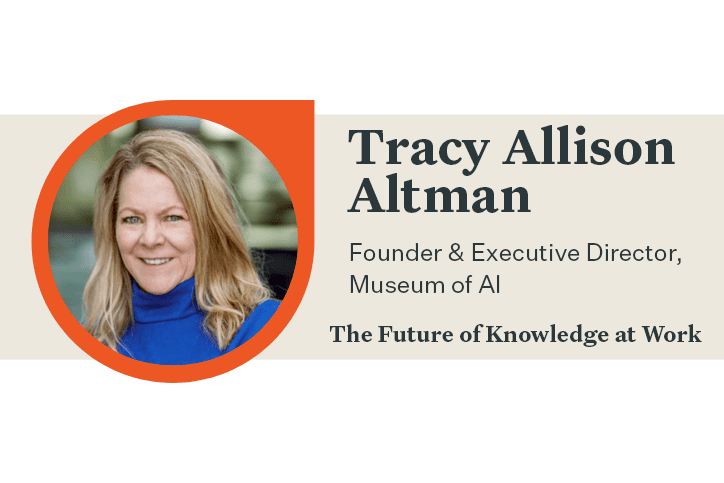Bloomfire Q&A: Tracy Allison Altman on the Future of AI, Interactive B2B Learning, and More

Artificial intelligence (AI) technology is crucial to the future of knowledge management: the more data, content, and insights that become available, the more important it is to have an automated system to manage that information and make it digestible for humans. The role of AI in knowledge management is one of our favorite topics at Bloomfire, so we were happy to have the opportunity to interview Tracy Allison Altman, founder of the Museum of AI.
The Museum of AI creates interactive pop-up experiences to show what it’s like to work with artificial intelligence. In her role as Executive Director, Tracy leads the production of simple, understandable explanations for complex topics. For example, a Museum of AI installation might include interactive steps walking people through an algorithm that predicts buyer behavior to reveal the assumptions and data going into a decision.
Tracy recognizes that we’re all under pressure to share knowledge with each other—and with machines. “People must learn to distinguish what is generally accepted as true, what is subject to interpretation, and what is inaccurate,” she tells us. “To avoid misguided efforts and disappointing outcomes, knowledge must be transparent and accessible. That’s what my work has always been about.”
Check out our full conversation below.
1. Tell us a little about yourself.
I found my calling when I learned how to make complex knowledge easily consumable. Math and science speak to me. I studied Chemical Engineering and had technical management roles. My Master’s is in Applied Math. I’ve taught school, developed environmental models, and led financial analysis.
My PhD in Public Policy Analysis looked at the big picture: How do people know what they know? What is the best way to share data that nudges people toward better outcomes? How do leaders explain complex decisions?
2. Can you tell us a little about the Museum of AI and how you founded it?
The Museum of AI creates experiences (online and in-person) showing people what it’s really like to work with artificial intelligence. Beneath our light-hearted, experiential aesthetic, we support rigorous learning objectives about algorithmic decision-making, human-AI collaboration, and analytics.
I developed the concept after seeing phenomenal consumer experiences—things like escape rooms, Meow Wolf, and Jejune Institute. Compare those to the sterile content and engagement offered to business professionals. So I gathered a team of installation artists, writers, educators, and technologists [to create the Museum of AI]: our B2B experiential builds understanding of key AI principles.
3. How did you first get interested in the intersection between AI and human decision-making?
My study of human decision-making coincided with the Rise of the Machines, so it was a natural fit. It’s incredibly difficult to understand how people know what they know, and decide what they decide. Oftentimes we don’t or can’t articulate this to others, and sometimes we don’t understand it ourselves.
It’s equally difficult, and just as important, to understand how machines “know” what they know, and how algorithms make recommendations or choices. As Human-AI collaboration evolves, we’ll need to continually assess how to work together and ask questions such as: What counts as a satisfactory explanation? Who can override who?
4. What knowledge do you rely on most in your role as Executive Director for the Museum of AI?
I rely on interdisciplinary knowledge: stating key objectives and then identifying the many sources of knowledge to be wrangled to accomplish those objectives.
I need to have a solid handle on artificial intelligence use cases while understanding how adults learn (principles of andragogy). Combine that with fundraising, marketing, and art design, and you’re looking at a very diverse team. Leading this interdisciplinary activity is a fun challenge: the subject matter experts bring ideas unique to their experience, and I guide activity to keep it aligned with the museum’s vision.
5. What do you think are the biggest knowledge management challenges facing business decision-makers today (and how do you overcome them)?
One challenge is the lack of common language between people and machines: our different ways of representing knowledge add a ton of friction when interpreting back and forth. When executives adopt a new technology, it’s a perfect time to raise expectations for knowledge sharing. Make communications about something specific to business outcomes so they can be structured and discovered by others. For example, if it’s a predicted outcome, or a proposed action, you could structure their knowledge around that: People could explicitly label their contribution as Proposed Action –> Predicted Outcome.
Another challenge is distinguishing between ‘little k’ and ‘Big K’ knowledge, and who has control over next steps.
Many organizations are shifting to workflows where frontline or less-senior staff are making more decisions. This requires them to have knowledge at their fingertips. But what knowledge? For real-time tactical decisions, people tend to rely on what I call ‘little k’ knowledge: experience and data relevant to a well-defined situation, such as a particular UX design choice. ‘Big K’ knowledge is different and must be managed differently. For far-reaching decisions, executives need to combine their deep industry expertise with historical patterns, research findings, and model predictions. There’s a strong emphasis on evidence showing ‘why’, and heavy reliance on human insights.
6. What best practices would you recommend for capturing and sharing knowledge?
1. Capture the why, not just the what. Establish a culture where people are expected to transparently explain their design choices, marketing plans, and other work with supporting evidence. Set expectations that people state their predicted outcomes, and provide straightforward analytical tools so they can share knowledge that’s rooted in critical thinking.
2. Differentiate based on quality. Systems can learn to recognize who is contributing, and who is sharing knowledge that’s evidence-based and particularly relevant to business outcomes (even if the outcome doesn’t result as predicted). This is the high-quality knowledge you want to be discoverable. Again, implementing a new system is a perfect time for managers to model desired practices for knowledge sharing.
7. Thoughts on how new technologies will impact the way people share knowledge across their organizations?
Technology will continue to eliminate drudgery and dull, repeatable tasks with tools such as robotic process automation (RPA). This should free people up to capture and share the knowledge that’s most important, the stuff the machines can’t do on their own. I hope people will be inspired to create new ways to present knowledge, to make it more understandable, accessible, and reusable.
I expect to see the language of knowledge transfer evolve so that people can more easily identify valid sources of knowledge based on completeness, sources, and explanations of why their recommended action will lead to a specific outcome.
8. What’s one prediction you have for how AI-powered technology will change the workplace in the next decade?
I predict that AI will make the best people better and that the weakest performers will go by the wayside. This sounds harsh, but companies can’t afford to keep weak talent, and their AI-powered tools will automate many of the simpler tasks.
I believe that as AI gets smarter and better at explaining itself, the strongest people will learn from that and develop a better understanding of how to make systematic, high-quality decisions. They will thrive, contribute more value, and learn to explain knowledge that’s rigorous and understandable.
Thank you for sharing your insights and perspective with us, Tracy!
Interested in more perspectives on the role AI will play in the future of work and knowledge management? Check out these interviews:
Overstock’s Kamelia Aryafar on AI, an Experiment-Driven Culture, and More
Thomas Wieberneit on Digital Transformation and a Culture of Knowledge Sharing
Andria Long on Innovation as a Team Sport and Getting to Insights Faster

A SharePoint Alternative That Unlocks Enterprise Intelligence

What Is Enterprise AI Search? (And Why Your Business Needs It)

The Value in Knowledge Sharing Sessions

Start working smarter with Bloomfire
See how Bloomfire helps companies find information, create insights, and maximize value of their most important knowledge.

Take a self guided Tour
See Bloomfire in action across several potential configurations. Imagine the potential of your team when they stop searching and start finding critical knowledge.